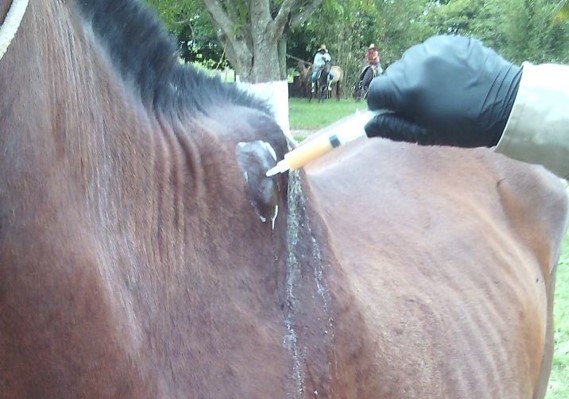Isolation of Brucella abortus in equines with supraspinous bursa, dedicated to herding cattle
Keywords:
equines, brucellosis, cattle, MexicoAbstract
In Mexico there are no reports of Brucella abortus isolation in equines. The objective of this study was to isolate B. abortus in equines with clinical signs of chronic suppurative bursitis on the withers and nape of the neck, dedicated to herding cattle in a dual-purpose herd located in Tabasco, Mexico. In the 48 working equids of this farm, horses, donkeys and mules, a serological card test was performed, resulting 25% positive, of them three horses and one mule, which presented abscesses and fistulas of the withers and nape, samples of the purulent material were collected by aspiration, from the four exudate samples B. abortus was isolated and identified by conventional methods and PCR. We report the first isolation in Mexico of B. abortus from working horses and mules from a herd of cattle with brucellosis.
http://dx.doi.org/10.21929/abavet2022.36
e2022-29
References
ACOSTA GRI, González RI. Flores GGH. 2006. Prevalence of Brucella abortus antibodies in equine of a tropical region of Mexico. Canadian Journal of Veterinary Research. 70(4): 302-304. https://www.ncbi.nlm.nih.gov/pmc/articles/PMC1562530/
ALTON GG, Jones LM, Angus RD, Verger JM. 1988. Techniques for the Brucellosis Laboratory. Institute National de La Recherche Agronomique Paris. Pp. 192. https://www.ncbi.nlm.nih.gov/pmc/articles/PMC7130219/
ARDO MB, Abubakar DM. 2016. Seroprevalence of horse (Equus caballus) brucellosis on the Mambilla plateau of Taraba State, Nigeria. Journal Equine Science. 27(1):1-6. https://doi.org/10.1294/jes.27.1
BERTU WJ, Ducrotoy MJ, Muñoz PM, Mick V, Zúñiga-Ripa A, Bryssinckx W, Kwaga JK, Kabir J, Welburn SC, Moriyón I, Ocholi RA. 2015. Phenotypic and genotypic characterization of Brucella strains isolated from autochthonous livestock reveals the dominance of B. abortus biovar 3a in Nigeria. Veterinary Microbiology. 180: 103-108. https://doi.org/10.1016/j.vetmic.2015.08.014
CUELLO GF, Angiano AB, Uceda AG, Burgos ES, Espejo EJ. Garrido CA. 1983. Brucelosis equina. Estudio serológico de algunos casos. Archivos Zootecnia. 32: 160-165. http://hdl.handle.net/10396/3148
DUFF HM. 1937. Brucella abortus in the horse. Journal of Comparative Pathology and Therapeutics. 50:151-158. ISSN 0368-1742.
https://doi.org/10.1016/S0368-1742(37)80018-1
DE MASSIS F, Zilli K, Di Donato G, Nuvoloni R, Pelini S, Sacchini L, D'Alterio N, Di Giannatale E. 2019. Distribution of Brucella field strains isolated from livestock, wildlife populations, and humans in Italy from 2007 to 2015. PloS one. 14(3), e0213689. https://doi.org/10.1371/journal.pone.0213689
HERNÁNDEZ ALO. 2012. Determinación de la seroprevalencia de Brucella abortus en caballos en México. [Tesis Licenciatura]. Universidad Nacional Autónoma de México, México. https://ru.dgb.unam.mx/handle/DGB_UNAM/TES01000686005
HUSSAIN A, Jamil T, Tareen AM, Melzer F, Hussain MH, Khan I, Saqib M, Zohaib A, Hussain R, Ahmad W, Iqbal M, Neubauer H. 2020. Serological and Molecular Investigation of Brucellosis in Breeding Equids in Pakistani Punjab. Pathogens. 9(9):673-680. https://doi.org/10.3390/pathogens9090673
JUNQUEIRA DG Jr, Dorneles EM, Gonçalves VS, Santana JA, Almeida VM, Nicolino RR, Silva MX, Mota AL, Veloso FP, Stynen AP, Heinemann MB, Lage AP. 2015. Brucellosis in working equines of cattle farms from Minas Gerais State, Brazil. Preventive Veterinary. Medicine. 121(3-4):380-385.
https://doi.org/10.1016/j.prevetmed.2015.06.008
KARTHIK K, Prabakar G, Bharathi R, Khurana SK, Dhama K. 2016. Equine brucellosis: Review on epidemiology, pathogenesis, clinical signs, prevention and control. Journal of Experimental Biology and Agricultural Sciences. 4.
https://doi.org/10.18006/2016.4%28SPL-4-EHIDZ%29.S151.S160
LORD V, Laserna R. Melendez G. 1986. Seroprevalencia de brucelosis en caballos de Venezuela. Veterinaria. Tropical. 11(1): 31-42.
https://jineteycaballo.blogspot.com/2013/11/seroprevalencia-de-brucelosis-en.html
LOFTI Z, Pourmahdi Borujeni M, Ghorbanpoor M, Ghadrdan Mashhadi AR. 2022. Seroprevalence and risk factors of brucellosis in Arabian horses. Veterinary Medicine Science.1-9. https://onlinelibrary.wiley.com/doi/pdf/10.1002/vms3.759
LUCERO NE, Ayala SM, Escobar GI, Jacob NR. 2008. Brucella isolated in humans and animals in Latin America from 1968 to 2006. Epidemiology.and infection. 136 (4):496-503. https://doi.org/10.1017/S0950268807008795
LUNA-MARTÍNEZ JE, Mejía-Terán C. 2002. Brucellosis in Mexico: current status and trends. Veterinary Microbiology. 90(1-4):19-30.
https://doi.org/10.1016/s0378-1135(02)00241-9
MACCAUGHEY W, Kerr WR. 1967. Abortion due to brucellosis in a thoroughbred mare. Veterinary Record. 80:186-187. https://doi.org/10.1136/vr.80.5.186
MORENO E. 2021. The one hundred year journey of the genus Brucella (Meyer and Shaw 1920). FEMS Microbiol Rev. 45(1):fuaa045. https://doi.org/10.1093/femsre/fuaa045
NJOGA E. 2018. Seroepidemiology of equine brucellosis and role of horse carcass processors in spread of Brucella infection in Enugu State, Nigeria. 10.
https://doi.org/10.7324/IJCRR.2018.10106
MUHAMMAD A, Tijjani AN, Auwal MS, Mustapha AR,Gulani BS. 2013. Serological prevalence of Brucellosis among donkeys (Equus asinus) in some local government areas of Yobe State, Nigeria. J. Equine Veterinary Science. 33(3): 150-154.
https://doi.org/10.1016/j.jevs.2012.05.071
RESENDE CF, Santos A, Filho P, de Souza P G, Issa MA, Filho M, Victor R M, Câmara R, Gonçalves GP, Lima JG, Maciel E, Silva, AG, Leite RC, Reis J. 2022. Glanders and brucellosis in equids from the Amazon region, Brazil. Acta tropica, 231, 106429.
https://doi.org/10.1016/j.actatropica.2022.106429
RODRÍGUEZ-VARGAS M, Sánchez-Villalobos A, Becerra-Ramírez L, Cordero Robert. 2010. Utilidad de las técnicas fluorescencia polarizada y del inmunoensayo enzimático de competencia para diagnóstico de brucelosis en caballos purasangre de carreras. Interciencia, 35(2):131-135. ISSN: 0378-1844.
https://www.redalyc.org/articulo.oa?id=33913150009
SAGARPA (Secretaria de Agricultura, Ganadería y Desarrollo Rural). 1996. Campaña Nacional contra la Brucelosis en los Animales. NOM-041-ZOO-1995. Diario Oficial de la Federación. Pp. 22. https://www.gob.mx/cms/uploads/attachment/file/106184/NOM-041-ZOO-1995.pdf
SANGARI FJ, Garcia-Lobo JM, Agüero J. 1994. The Brucella abortus vaccine strain B19 carries a deletion in the erythritol catabolic genes. FEMS. Microbioogy Letters. 121(3): 337-342. https://doi.org/10.1111/j.1574-6968.1994.tb07123.x
SEGOB. (Secretaría de Gobernación). 2016. Enciclopedia de los Municipios y Delegaciones de México. Estado de Tabasco. Instituto para el Federalismo y el Desarrollo Municipal.
http://www.inafed.gob.mx/work/enciclopedia/EMM27tabasco/index.html
TAHAMTAN Y, Namavari, MM, Amrabadi, OR. 2015. Prevalence of Brucella spp. in equines of Iran. Comparative Clinical Pathology. 24: 1479–1481.
https://doi.org/10.1007/s00580-015-2103-2
VEMULAPALLI R, Mcquiston JR, Schurig GG, Sriranganathan N, Halling SM, Boyle SM, 1999. Identification of an IS711 element interrupting the wboA gene of Brucella abortus vaccine strain RB51 and a PCR assay to distinguish strain RB51 from other Brucella species and strains. Clinical and Diagnostic Laboratory Immunology. 5(6):760-764. https://pubmed.ncbi.nlm.nih.gov/10473532/



